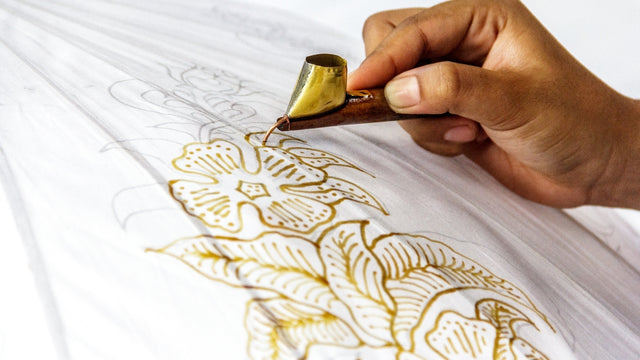Popular Jenis Batik Malaysia: Traditional Art Patterns
Malaysian batik is a vibrant representation of the country’s rich heritage, primarily crafted in the eastern states of Kelantan, Terengganu, and Pahang, which contribute 42%, 36%, and 22% respectively to the overall batik production.
The art form is distinguished by its beautiful motif batik malaysia, predominantly featuring nature-inspired designs such as flowers and leaves, deliberately avoiding intricate depictions of animals or humans in adherence to Islamic customs.
The unique brush painting technique employed sets batik tradisional malaysia apart from its Indonesian counterpart, allowing for larger and simpler patterns with vivid colours, thus highlighting the cultural significance of batik in daily Malaysian life. Celebrated annually on December 3rd as "Malaysia Batik Day," this artistic form has become a national symbol, reflecting the nation’s identity and traditions.

Key Takeaways
- Malaysian batik is produced primarily in Kelantan (42%), Terengganu (36%), and Pahang (22%).
- Nature-inspired motifs, particularly leaves and flowers, dominate Malaysian batik designs.
- The brush painting technique in Malaysia leads to larger, simpler patterns compared to Indonesian batik.
- December 3rd is celebrated as "Malaysia Batik Day," underscoring its cultural importance.
- Hand-drawn batik, or batik tulis, is more exclusive and valued for its meticulous craftsmanship.
History of Batik in Malaysia
The history of batik in Malaysia is rich and deeply interconnected with the nation's cultural evolution. Originating from trade routes established in the 13th century, batik traditions were influenced by the exchange of ideas and techniques with Java. This trading relationship allowed batik traditions to flourish, leading to the creation of the batik tradisional malaysia style that is celebrated today. The craftsmanship evolved as artisans transitioned from woodblocks to using wax and copper blocks by the 1920s, solidifying a distinctively Malaysian aesthetic.
Origins and Influences
Batik's origins trace back to historical interactions with neighbouring regions. Early batik techniques, initially imitated using woodblocks, eventually transformed, allowing for the emergence of batik malaysia tenun. As the techniques developed, Malay craftsmanship began to distinguish itself from other Southeast Asian styles, emphasising large, simplified patterns and innovative colour use. The states of Kelantan and Terengganu are particularly noted for their contributions to batik, showcasing unique motifs that resonate with cultural narratives.
Cultural Significance
The cultural significance of batik is profound, woven into the fabric of Malay identity. Textiles often serve as a representation of batik negeri sembilan, reflecting the diverse communities throughout Malaysia. Batik appears in formal attire, symbolising tradition and pride in Malaysian heritage. Initiatives by the government encourage the use of batik, with civil servants required to wear it on designated days, underscoring its importance in contemporary society. Batik has also become a popular choice for both locals and tourists, frequently chosen as a souvenir, thus enhancing its role as a cultural artefact within Malaysia.
Jenis Batik Malaysia: Varieties and Designs
The fascinating world of Malaysian batik encompasses a range of traditional techniques and regional specialties, each contributing to the vibrant tapestry of this cultural heritage. This section explores the intricate craftsmanship and unique characteristics found in batik across different states.
Traditional Techniques
Various techniques define the artistry of batik, with each offering a unique approach to creating stunning fabric designs. The most renowned methods include:
- Batik Tulis: Hand-drawn batik, often regarded as a premium product due to its time-intensive process.
- Batik Cap: Stamped batik, which allows for quicker production yet maintains authenticity.
- Batik Blok: Involves using carved blocks to imprint wax designs, resulting in intricate patterns.
- Batik Lukis: Features painted wax, promoting creativity and fluid artwork.
Each technique showcases the dexterity of local artisans, ensuring a dynamic range of colour and design.
Regional Specialties
The distinct regions of Malaysia present their own flavours in batik, reflecting local culture and traditions:
- Batik Kelantan: Known for bold colours and geometric patterns.
- Batik Terengganu: Features delicate pastel shades and motifs inspired by local flora and fauna.
- Batik Pahang: Emphasises earthy tones and nature-themed designs.
- Batik Melaka: A blend of diverse cultural influences, including Chinese and Indian elements.
- Batik Sarawak: Reflects the unique patterns of various indigenous tribes using natural dyes from local plants.
This regional diversity enriches the Malaysian batik scene, offering wearers a wide array of styles to choose from.
Popular Motifs
The motifs in Malaysian batik serve more than aesthetic appeal; they encapsulate stories and cultural heritage. Common designs include:
- Depictions of local flora, such as hibiscus and jasmine.
- Fauna motifs featuring butterflies and fish.
- Geometric and abstract patterns that exemplify creativity in craftsmanship.
These motif batik malaysia designs highlight the intricate relationship between the nation's cultural narratives and its rich biodiversity, making each piece a true representation of Malaysian heritage.
Conclusion
In summary, jenis batik Malaysia embodies an integral aspect of the nation's cultural identity, reflecting both historical and contemporary practices. Since its inception in the 1920s, the art of batik has flourished, characterised by exquisite motifs such as the Pucuk Rebung and the culturally significant Chempaka flower. These designs not only showcase the beauty of nature but also convey deeper meanings, illustrating the rich tapestry of Malaysia's diverse heritage.
The evolution of jenis batik Malaysia into various applications—extending beyond traditional attire to include home décor and souvenirs—demonstrates its versatility and enduring relevance. As techniques like hand-drawn and stamping batik continue to thrive, the integration of modern influences ensures that this traditional craft remains vibrant and accessible to future generations. This ongoing evolution is vital for preserving the artistry and significance of batik, making it a unique symbol of Malaysian pride.
As Malaysia embraces its artistic heritage, nurturing the craft of batik becomes essential not only for cultural preservation but also for economic sustainability. With support from initiatives by organisations like UNESCO and the World Crafts Council, jenis batik Malaysia is more than just a textile; it is a narrative of resilience, creativity, and identity that deserves to be celebrated and protected for years to come.


